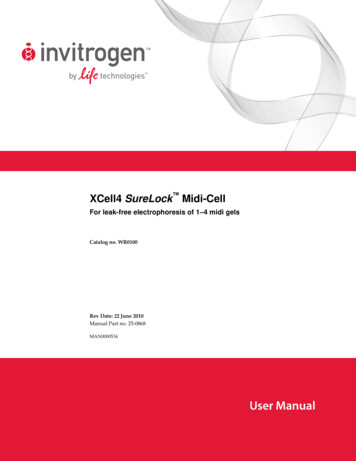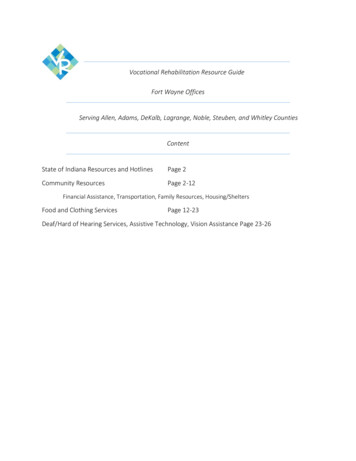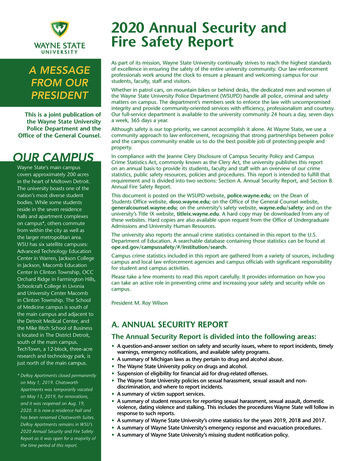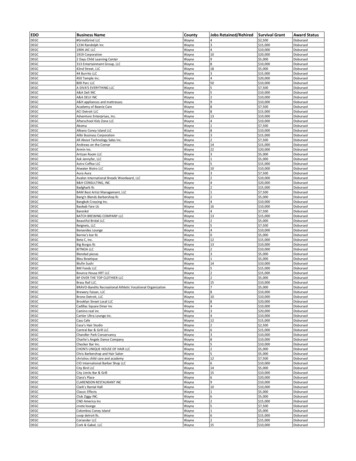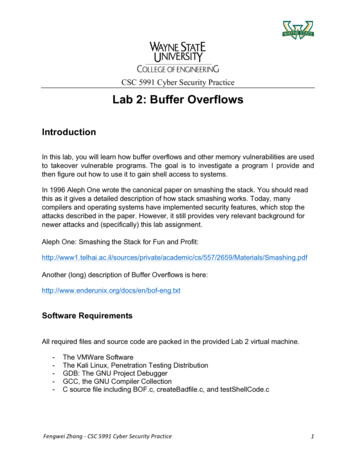
Transcription
CSC 5991 Cyber Security PracticeLab 2: Buffer OverflowsIntroductionIn this lab, you will learn how buffer overflows and other memory vulnerabilities are usedto takeover vulnerable programs. The goal is to investigate a program I provide andthen figure out how to use it to gain shell access to systems.In 1996 Aleph One wrote the canonical paper on smashing the stack. You should readthis as it gives a detailed description of how stack smashing works. Today, manycompilers and operating systems have implemented security features, which stop theattacks described in the paper. However, it still provides very relevant background fornewer attacks and (specifically) this lab assignment.Aleph One: Smashing the Stack for Fun and ademic/cs/557/2659/Materials/Smashing.pdfAnother (long) description of Buffer Overflows is oftware RequirementsAll required files and source code are packed in the provided Lab 2 virtual machine.-The VMWare SoftwareThe Kali Linux, Penetration Testing DistributionGDB: The GNU Project DebuggerGCC, the GNU Compiler CollectionC source file including BOF.c, createBadfile.c, and testShellCode.cFengwei Zhang - CSC 5991 Cyber Security Practice1
Starting the Virtual MachineThe Kali Linux VM has all the required files. Select the VM named Lab2BufferOverflows for this lab.Login the Kali Linux with username csc5991-student or root, and password [TBA in theclass].In the Kali Linux, you should be able to see a folder named Lab2-BufferOverflows. Thisfile contains all of the source code for the lab 2.Fengwei Zhang - CSC 5991 Cyber Security Practice2
Setting up the EnvironmentThere are many protections in current compilers and operating systems to stop stackattacks like the one we want to do. We have to disable some security options to allowthe exploit to work (Note that the VM image you get has configured the environemnt).Disable Address Space Layout RandomizationAddress Space Layout Randomization (ASLR) is a security features used in mostOperating system today. ASLR randomly arranges the address spaces of processes,including stack, heap, and libraries. It provides a mechanism for making the uxusingthe/proc/sys/kernel/randomize va space interface. The following values are supported:0 – No randomization1 – Conservative randomization2 – Full randomizationDisable ASLR, run: echo 0 /proc/sys/kernel/randomize va spaceEnable ASLR, run: echo 2 /proc/sys/kernel/randomize va spaceNote that you will need root privilege to configure the interface. Using vi to modify theinterface may have errors. The screenshot below shows the value of/proc/sys/kernel/randomize va spaceHowever, this configuration will not survive after a reboot. You will have to configure thisin sysctl. Add a file /etc/sysctl.d/01-disable-aslr.conf containing:kernel.randomize va space 0This will permanently disable ASLR.Fengwei Zhang - CSC 5991 Cyber Security Practice3
The screenshot below shows you the ASLR configuration. You can open aand try it out.terminalSet compiler flags to disable security featuresWhen you compile the vulnerable program (explain in the next section) with gcc, use thefollowing compiler flags to disable the security features.-z execstackTurn off the NX protection to make the stack executable-fno-stack-proectorRemove StackGuard that detects stack smashing exploitations-gEnable the debugging symbolsFengwei Zhang - CSC 5991 Cyber Security Practice4
OverviewThe goal of the exploitation is to teach you how buffer overflows work. You must gain ashell by passing a malicious input into a vulnerable program. The vulnerabilitytakes as input a file named "badfile". Your job is to create a badfile that results in thevulnerable program producing a shell. Note that you also have a nop sled to make thevulnerability work even if your shellcode moves by a few bytes. In the Lab2BufferOverflows folder, it contains the C files you need to use. The screenshot belowshows that.BOF.cIn BOF.c there is an un-bounded strcpy, which means anything that is not nullterminated will overwrite the buffer boundaries and (hopefully) put some information intothe stack that you will design. Your exploit must work with my version of BOF.c (can'tchange it to make your code work).Fengwei Zhang - CSC 5991 Cyber Security Practice5
To compile BOF.c, you need to add the compile flags mentioned. gcc –g –z execstack –fno-stack-protector BOF.c –o BOFFengwei Zhang - CSC 5991 Cyber Security Practice6
testShellCode.cThis program simply lets you test shell code itself. There are a lot of different "shellcodes" you can find or create, and this is a good way to see what they do, and if they'llwork for you (on your operating system).The actual shellcode you are using is simply the assembly version of this C code:#include stdio.h int main( ) {char *name[2];name[0] "/bin/sh";name[1] NULL;execve(name[0], name, NULL);}Fengwei Zhang - CSC 5991 Cyber Security Practice7
createBadfile.cThis program writes out "badfile", however currently it is just full of nops (no ops). Youneed to modify it to place your shell code into it and cause the code to jump to theshellcode. The shellcode included already in badfile (as a char array) does work. Youshouldn't need to modify it, but you're welcome to.To compile the testShellCode.c and createBadfile.c, you do not need to add the compileflags mentioned early. You can just simplely compile it with gccFengwei Zhang - CSC 5991 Cyber Security Practice8
Starting the ExploitationThere are really two challenges in the lab. To execute the shellcode you want tooverwrite the return address in the bufferOverflow() function. You must make the returnaddress of that function point to your shellcode.1. You need to figure out what memory address the return address is stored in.2. Then you need to figure out the address of your shellcode in memory, and write theshellcode's address into the return address you found in step 1.In the lab instruction, I will give you some hints for the step 1.Finding Return Address on the StackIn order to find the return address on stacks, we first use GDB, The GNU ProjectDebugger, to take a look at the assembly code. You can find more information aboutGDB from here: https://www.gnu.org/software/gdb/ Note that you can also use tool,objdump, to read the assembly code. gdb BOFFengwei Zhang - CSC 5991 Cyber Security Practice9
First, we disassemble the main() function of the BOF program. We find thebufferOverflow() function in the main() function (type disas main in the GDB). Then, wedisassemble the bufferOverflow() function, which has a vulnerability in it. (gdb) disas main (gdb) disas bufferOverflowYou need to understand the assembly code to find where the return address is on thestack. Next, type run in the GDB to execute the BOF program. (gdb) runAs we expected, the BOF program generates an exception, segmentation fault. TheInstruction Pointer (EIP) is 0x90909090. This is because we put NOP sleds on thebadfile that overflows the buffer in the BOF program.Fengwei Zhang - CSC 5991 Cyber Security Practice10
You also can see more register information by execute info register in the GDB (gdb) info registerNote that you can always type help in the GDB to learn the commands.Fengwei Zhang - CSC 5991 Cyber Security Practice11
Assignments for the Lab 2A zip file containing:1. Your updated createBadfile.c that generates the input for the BOF program2. A copy of the badfile. This must gengerate a shell when BOF runs from thecommand line in the VM3. A screenshot of using BOF program to gain a shell (see simple screenshotbelow)4. A text file with answers to the following questions:a. What happens when you compile without “-z execstack”?b. What happens if you enable ASLR? Does the return address change?c. Does the address of the buffer[] in memory change when you run BOFusing GDB, /BOF,and ./BOF?Happy Exploiting!Fengwei Zhang - CSC 5991 Cyber Security Practice12
Fengwei Zhang - CSC 5991 Cyber Security Practice 4 The screenshot below shows you the ASLR configuration. You can open a terminal and try it out. Set compiler flags to disable security features When you compile the vulnerable program (explain in the next section) with gcc, use the following compiler flags to disable the security features.







